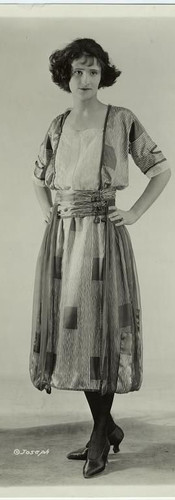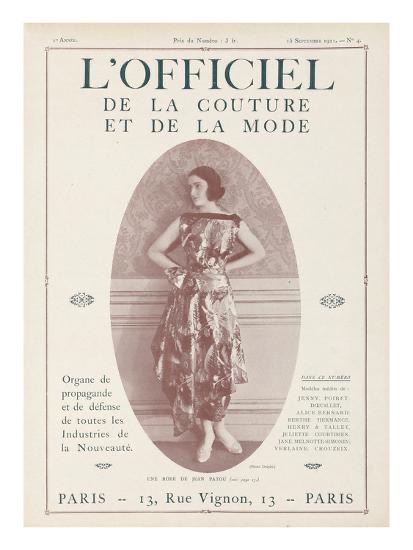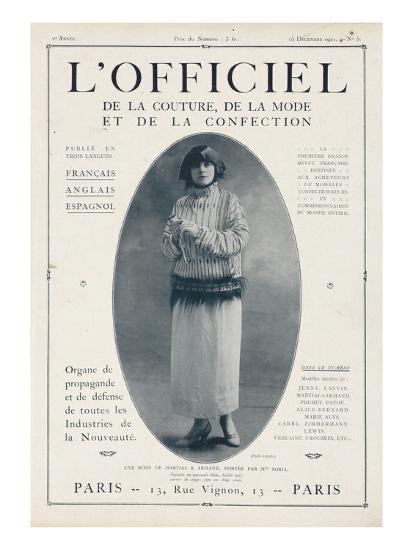A Scrapbook of 1921 fashions
For Canada, 1921 was a better year than 1920: William Lyon McKenzie King, Canada’s longest serving Prime Minister (and popular at the time), was voted in for the first time; Agnes Macphail became the first woman to be elected to Parliament; and University of Toronto biochemists Drs. Banting and Best announced the discovery of insulin for treating diabetes. Some Canadians were also happy that prohibition began to be repealed through plebiscites. However, for much of the rest of the world, 1921 was a difficult year.
In the United States, Warren G. Harding became president on March 4. In an effort to curb high unemployment, Harding signed the Emergency Quota Act that restricted the number of immigrants to three percent of those from countries already in the U.S. as of 1910. The Act especially limited Eastern and Southern European immigrants. As a result, Eastern European Jews began to immigrate to Palestine instead of the U.S.

Immigrants at Ellis Island, 1921
A race riot in Tulsa, Oklahoma began with an accusation by a white woman of being assaulted by a black man. Although the charges were dismissed, sensationalist media coverage fueled fear and misinformation and the event escalated into a two day conflict that left the prosperous black neighbourhood of Greenwood a smouldering ruin with over 300 dead and a thousand injured.
The Russian Socialist Federative Soviet Republic (as it was known from 1917 to 1922) was in the midst of a civil war. In March 1921, a rebellion by Russian sailors in the city of Kronstradt ended with thousands of deaths. A famine brought about by a combination of the civil war, bad government policies, and a severe drought gripped the new country. It is estimated that by the time the famine ended in 1923, five million Russians had died.
World War I was finally concluded when a treaty between the United States and Germany was signed (the U.S. had not ratified the Treaty of Versailles in 1919.) Reparations were determined by the allies that required Germany to pay the equivalent of 2.5 billion gold marks per annum to a total of 132 billion gold marks. Germany printed money to make payments, which lead to hyperinflation, riots, and the assassination of the former Finance Minister. (the debt was finally paid off in 2010.)
With general political unrest, Adolf Hitler became the chairman of the National Socialist German Workers Party. By the end of the year the Sturmabteilung (brownshirts or SA) had been established.

From 1921 to 1925 the Nazi Party offices were at 12 Corneliusstresse, Munich. This photo taken in 1921
For those looking for a median between extreme politics, the new word ‘centrism ’ was coined, although extremes seemed to be growing faster than middle-of-the-road politics. The International Working Union of Socialist Parties was founded in Vienna. Throughout the year Communist parties were established in Italy, Belgium, South Africa, Czechoslovakia, Portugal, Spain, and China (by founding member Mao Tse-tung.) In Italy, Mussolini founded the National Socialist Party, which won 29 seats in a parliamentary election that year.
There were labour strikes by miners in Britain, the United States, and South Africa, and a general strike in Norway. Unrest elsewhere led to the assassination of the Spanish Premier, as well as the Portuguese and Japanese prime ministers.
With anti-colonial riots in Egypt and home-rule battles in Ireland, Britain regrouped, creating the British Commonwealth of Nations. Afghanistan was given its sovereignty and Northern Ireland was created by an act of Parliament, paving the way for the creation of an Irish free state (Southern Ireland) with the signing of an Anglo-Irish treaty at the end of the year.

Anglo-Irish treaty envoys, 1921
Extreme weather events included: a summer heat wave in Europe, a geo-magnetic storm that caused extensive damage to electrical systems, especially along the Eastern seaboard of the U.S., and flash floods in Colorado that drowned 1500. A boll weevil infestation decimated Georgia cotton crops that led farmers to plant peanut crops instead.
The sinking of two ships, the Hong Koh in China and the Santa Isabel in Mexico, took over 1200 to their death, and a nitrate factory explosion in Oppau, Germany killed over 500. An outbreak of Sleeping Sickness in the U.S. claimed nearly 1,000 lives, and Franklin Roosevelt contracted Polio while swimming at Campobello, Nova Scotia, rendering him a paraplegic.
Catching world attention was the trial of Nicola Sacco and Bartolomeo Vanzetti, two Italian-born anarchists who were convicted for the murder of two men and the robbery of a Massachusetts shoe company’s payroll. Conflicting evidence and recanted testimony did not sway the jury, and despite protests around the world, the cause celebres case ended with their eventual execution in 1927.
The New York Yankees purchased 20 acres in the Bronx to build Yankee Stadium. Their star player, Babe Ruth hit his 138th home run in 1921 to become the all-time home run leader in Baseball. Ruth would go on to extend his home-run record to a total of 714 by the time he retired in 1935, a record that would stand until 1974. Also breaking records was boxing’s first million dollar gate to see Jack Dempsey knock out Georges Carpentier.

Babe Ruth in the 1921 World Series
A new dish introduced from Italy became popular – breaded and fried zucchini. Other new foods included: the Bloody Mary cocktail, sugared jelly candies, ‘iodized’ salt, and chocolate covered ice cream bars called ‘I-scream’ bars. They were soon renamed ‘Eskimo Pies’ and then renamed again in 2020 Edy’s pies (because Eskimo is now considered derogatory), after company founder Joseph Edy. New brands hit the grocery shelves: Wonder bread with its distinctive red, yellow and blue balloon-print packaging, Wheaties breakfast cereal, French’s mustard, and fictional company mascot and spokeswoman Betty Crocker for what would become General Mills Foods.
1921 also saw the birth of fast food with the creation of the White Castle hamburger chain. Founded in Wichita, Kansas, the steam fried hamburgers, 18 per pound of ground beef, were cooked on a bed of onions in an open kitchen where customers could see their food being prepared. The original burgers cost a nickel. At the higher end of dining, Sardi’s restaurant opened in New York City.
Top songs of the year included: Irving Berlin’s “All By Myself”; Marion Harris’ “I Ain’t Got Nobody”; Eddie Cantor’s “Margie”; Al Jolson’s “Avalon”; Ethel Waters “There’ll Be Some Changes Made”, and a host of dance tunes recorded by the band leader Paul Whiteman including “Song of India”, “Say it with Music”, and “Cherie”.
In theatre, the first major play of the Harlem Renaissance, “Shuffle Along,” debuted on Broadway, launching the career of Josephine Baker. In Prague, Karel Capek’s play “R.U.R”, which introduced the word “robot”, premiered.

British writer Agatha Christie published her first novel “The Mysterious Affair at Styles”, which introduced her character Hercule Poirot. New York publishers, The Little Review, were convicted of obscenity charges for publishing “Ulysses” in its entirety. The Best-selling English language books of 1921 included Main Street by Sinclair Lewis, and the Age of Innocence by Edith Wharton.

The top grossing Hollywood film of 1921 was “The Kid”, a full length comedy-drama written, produced, directed by, and starring Charlie Chaplin in his Tramp character, with Jackie Coogan playing the kid. The Four Horsemen of the Apocalypse, and The Sheik made Rudolph Valentino an international heart-throb. Star of Brewster’s Millions, comedian Roscoe ‘Fatty’ Arbuckle was arrested for fatally injuring Virginia Rappe at a party. Although he was acquitted of rape and manslaughter, the scandal ended his career.
As the world entered the modern era, old companies adapted to making new products. Studebaker, stopped making wagons to concentrate on automobiles and Boeing ceased furniture production to specialize in airplanes. The first electric home refrigerators came on the market, and more stations were broadcasting through wireless telephony (radio) – 1921 saw the first radio broadcasts in the U.S. of religious services and sports events. The German company Braun, Japanese company Mitsubishi, and the American company Radio Shack were all founded in 1921 as radio parts manufacturers.
1921 firsts include: the Corgi and Shih-tzu dog breeds, the polygraph lie detector test, Dude ranch holidays, pogo sticks, the colour fuchsia, Jungle gyms, ‘penthouse’ apartments, and a growing trend for initialism (I.B.M., I.R.A., and I.Q. all appeared in print for the first time.)
In 1921 your patootie (girlfriend), might slenderize (diet) to wear a slinky (close-fitting, sexually attractive garment) dress. Other new words for the year include the slang: applesauce (nonsense); goofy (silly); check-up (doctor’s exam); hitchhike (get a ride); derogatory terms (fag, dyke, and hebe); insults (lame-brain, schizoid, basket-case, skid-row, and goon); and the exclamations (shush and phooey).
Idioms first appearing in print in 1921 include: “he was taken to the cleaners”; “Send it down the pipeline”; “For crying out loud”; “Go off the deep end”; “Wrong side of the tracks”; “Look down your nose”; “Hot and bothered”; “For the hell of It”; “From the horse’s mouth”; “A spanner in the works”; “Between a rock and a hard place”; “Blow-by blow”; and “Cold turkey”.
In fashion, women’s styles were a little shorter and looser than they had been in 1920. Tops bloused over lower waistlines, and necklines were becoming more open. Transparent chiffon blouses and dresses that exposed forearms and collarbones through sheer fabric were gaining popularity.
Fashions from 1921
In Zion, Illinois, openwork stockings, and bare necks and arms in public places were banned, with fines of up to $200. A woman visiting Zion who was wearing a dress of transparent material that exposed her collarbone and forearms was arrested at the train station. Also, in 1921, Sunbury Pennsylvania regulated women’s skirts to be not shorter than 4 inches below the knee. Ohio would not allow a décolletage deeper than two inches, and even though not enacted, discussions about regulating dress styles took place across the U.S.
With shorter hemlines, women stopped wearing boots for daytime. Bar strap shoes had been popular since the 1890s for dressier occasions, but in 1921, the Mary-Jane pump (named for the character who played Buster Brown’s girlfriend in shoe advertising from the Brown Shoe Co.) with its instep strap became the most popular daytime style of footwear for women.
Men’s fashions changed little from the previous year, although the pant was becoming slightly fuller in cut. A new style – Plus Fours, were knickerbockers with an additional four inches in the leg to produce an overhang at the knee. It was popular at first with golfers, but the style caught on with collegiate-aged men for day wear.
Thomas Armour, 1921
The problem with plagiarism of Paris couture was taken on by Madeleine Vionnet when she targeted copyists, especially in the US, with a campaign in 1921 that saw the creation of The Association for the Defence of Fine and Applied Arts. The purpose was to register models and pursue counterfeiters. This was the origin of numbering and registering haute couture dress designs.
The magazine L’Officiel, the official publication of the Chambre Syndicale de la Couture Parisienne, was launched in 1921. This trade magazine was directed principally at international buyers, both corporate and individual, as well as those working in the fashion industry. In other fashion news, Chanel introduced her No. 5 perfume, and the luxury brand Gucci was founded in Florence.
1921 covers of L’Officiel magazine, left: September 15, right: December 1921

















